Arrowhead Plant
- November 1, 2023
- 0 comment
The Arrowhead Plant, also known by its botanical name Syngonium podophyllum, is a popular and attractive houseplant cherished for its elegant foliage and low-maintenance care requirements.


Native to the tropical rainforests of Central and South America, this versatile plant is characterized by its arrowhead-shaped leaves that can range in color from vibrant green to various shades of pink and cream, making it a visually appealing addition to any indoor space.
Arrowhead plants are well-suited for both novice and experienced plant enthusiasts, as they are relatively easy to care for, thriving in moderate to bright indirect light and requiring regular but not excessive watering. They can be grown in hanging baskets, as trailing vines, or potted with support to encourage upward growth. With its air-purifying qualities and adaptability, the Arrowhead Plant is a delightful choice for those looking to enhance their indoor environment with a touch of natural beauty.
| Characteristics | Description |
| Botanical Name | Syngonium podophyllum |
| Common Names | Arrowhead Plant, Arrowhead Vine, Goosefoot Plant |
| Family | Araceae |
| Native Habitat | Central and South American rainforests |
| Foliage | Arrowhead-shaped leaves, varying in color from green to pink and cream |
| Growth Habit | Vine or bushy, depending on how it’s cultivated |
| Light Requirements | Moderate to bright indirect light |
| Watering | Keep soil evenly moist but avoid overwatering; allow the top inch of soil to dry between waterings |
| Humidity | Thrives in medium to high humidity, benefits from occasional misting |
| Temperature | Ideal range is 60-75°F (15-24°C), sensitive to cold drafts |
| Soil Type | Well-draining potting mix with organic matter |
| Fertilization | Feed with balanced liquid fertilizer every 2-4 weeks during the growing season (spring and summer) |
| Pruning | Regularly prune to control growth and encourage bushiness |
| Toxicity | Mildly toxic if ingested; can cause irritation to pets and humans |
| Pests | Susceptible to aphids, mealybugs, and spider mites, but generally pest-resistant with proper care |
| Benefits | Air-purifying qualities, adds a touch of natural beauty to indoor spaces |
| Propagation | Easily propagated from stem cuttings in water or soil |
| Uses | Grown in hanging baskets, as a trailing vine, or potted with support for upward growth |
Botanical Beauty of the Arrowhead Plant
The Arrowhead Plant, scientifically known as Syngonium podophyllum, is a botanical marvel that has captured the hearts of plant enthusiasts worldwide. Its striking arrowhead-shaped leaves, which come in an array of captivating colors, make it a delightful addition to any indoor space. Let’s explore the botanical beauty of this charming houseplant and discover what sets it apart in the world of flora.

Woodland Elegance

Native to the lush tropical rainforests of Central and South America, the Arrowhead Plant thrives in environments known for their incredible biodiversity. It has evolved to exhibit a woodland elegance, reflecting the exquisite natural landscapes from which it hails. The leaves’ graceful shape and various shades of green, pink, and cream create an enchanting visual appeal that brings a touch of the wild into our homes.
Ecological Importance
Beyond its aesthetic allure, the Arrowhead Plant plays a role in supporting the ecological balance of its native habitats. In its natural environment, it provides shelter and sustenance for a variety of wildlife, including insects, birds, and small mammals. By growing these plants in our homes, we can pay homage to the ecological importance of this species, promoting a sense of conservation and preservation.
Cultivation and Conservation
Cultivating the Arrowhead Plant is a rewarding endeavor. It thrives in moderate to bright indirect light, making it adaptable to different indoor environments. Regular but not excessive watering keeps it healthy, and it can be grown as a trailing vine or potted with support to encourage upright growth. While it’s relatively easy to care for, it’s important to remember the conservation aspect. With the destruction of natural rainforests, maintaining these plants in our homes becomes an essential act of preserving biodiversity.

Fragrance
One of the hidden charms of the Arrowhead Plant is its subtle fragrance. While not as overpowering as some other flowering plants, it emits a gentle, pleasing aroma. The fragrance is especially noticeable when the plant is well cared for and its natural vitality is allowed to flourish, adding an olfactory dimension to its appeal.
Soil Stabilization
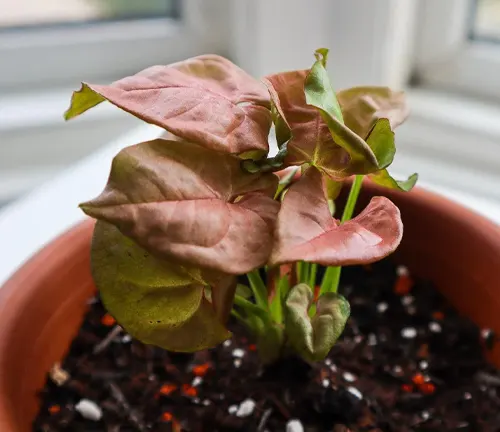
In its native environment, the Arrowhead Plant contributes to soil stabilization. Its roots help prevent soil erosion, maintaining the structural integrity of the rainforest floor. This natural function is a testament to the plant’s role in supporting the overall health of its ecosystem.
Common Uses
The Arrowhead Plant’s versatility extends beyond being a decorative houseplant. In its native regions, it has had traditional uses as a remedy for various ailments. It’s been utilized in herbal medicine for its potential healing properties, although such applications should be approached with caution due to its mild toxicity. The plant’s decorative appeal has also led to its use in floral arrangements, adding a touch of exotic beauty to bouquets and centerpieces.
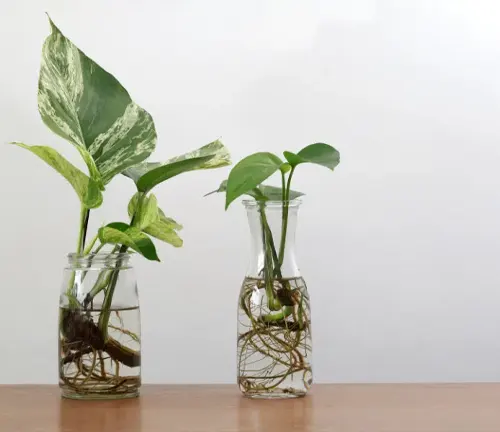
Benefits
One of the Arrowhead Plant’s most appreciated qualities is its ability to purify indoor air. Its lush foliage can help remove pollutants and toxins, contributing to a healthier and more enjoyable living space. Beyond its air-purifying abilities, this plant is a natural stress reliever, offering a sense of tranquility and connection to nature.
Different Species
Syngonium podophyllum
The standard Arrowhead Plant with green arrowhead-shaped leaves, sometimes with silver or cream variegation.

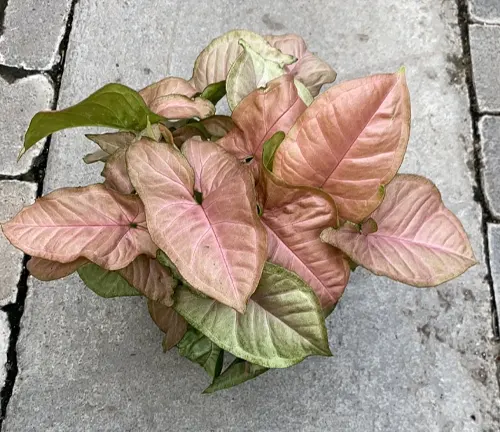
Syngonium podophyllum ‘Pink Allusion’
Known for its predominantly pink leaves with green veins, adding a pop of color to your indoor space.
Syngonium podophyllum ‘Maria’
A striking cultivar featuring dark green leaves with bold white veins, creating a marbled appearance.


Syngonium podophyllum ‘Neon Robusta’
With vibrant, almost neon-green leaves, this variety is an eye-catching addition to your plant collection.
Syngonium podophyllum ‘Confetti’
Named for its speckled leaves, which are a mix of green, white, and pink.
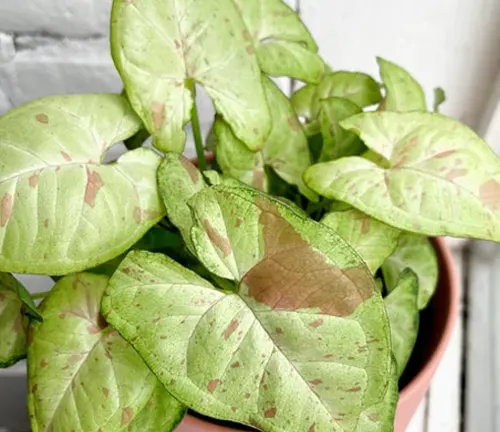

Syngonium podophyllum ‘Albo Variegata’
Highly sought after for its white variegation on green leaves, creating a visually stunning contrast.
Syngonium podophyllum ‘Holly’
This cultivar features leaves with silver and light green variegation, often in a holly-like pattern.
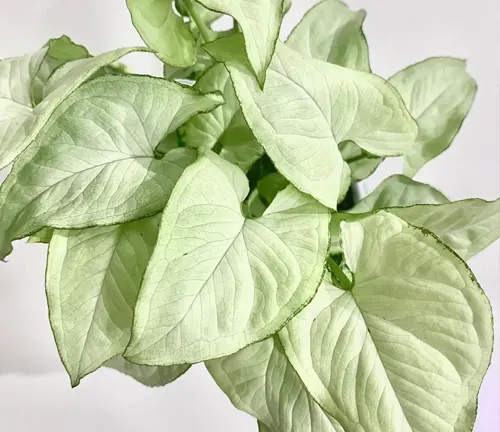
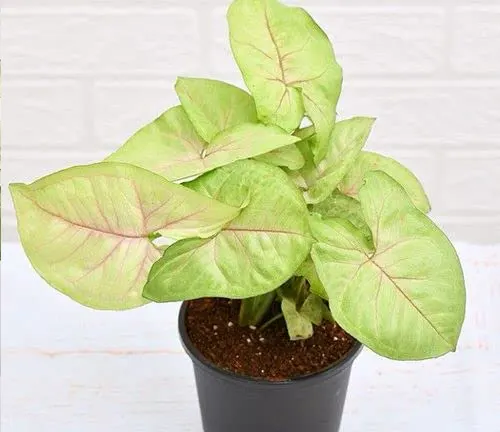
Syngonium podophyllum ‘Berry Allusion’
Known for its attractive pink and green variegated leaves that resemble berry hues.
Syngonium podophyllum ‘Albo-Marginata’
Features green leaves with a white margin, creating an elegant and clean look.
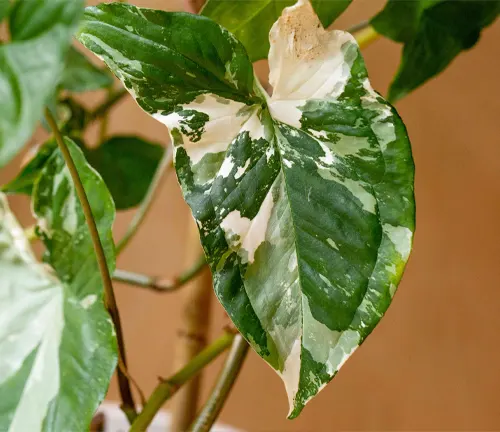

Syngonium podophyllum ‘Moonshine’
This variety has silvery-gray leaves, adding a touch of moonlit charm to your space.
Frequently Asked Questions (FAQs)
- What is an Arrowhead Plant?
The Arrowhead Plant, scientifically known as Syngonium podophyllum, is a popular houseplant known for its arrowhead-shaped leaves and attractive foliage. It is native to Central and South American rainforests. - How do I care for my Arrowhead Plant?
Arrowhead Plants thrive in moderate to bright indirect light and require regular but not excessive watering. Keep the soil consistently moist and provide adequate humidity, especially during drier months. Regular pruning can help control growth and promote bushiness. - Is the Arrowhead Plant toxic to pets and humans?
Yes, the Arrowhead Plant is considered mildly toxic if ingested. It can cause irritation and discomfort if consumed by pets or humans, so it’s important to keep it out of reach of curious children and pets. - What are some common issues with Arrowhead Plants?
Common issues include overwatering, which can lead to root rot, and pests such as aphids, mealybugs, and spider mites. Proper care and regular inspection can help prevent and address these problems. - How do I propagate an Arrowhead Plant?
Arrowhead Plants can be propagated through stem cuttings. Simply snip a healthy stem with a few nodes, place it in water or soil, and new roots will develop. Water propagation is a popular method. - Can I grow Arrowhead Plants outdoors?
Arrowhead Plants are primarily grown as indoor houseplants in most regions. However, in warm, tropical climates, they can be cultivated outdoors in shaded or protected areas. - Why are the leaves of my Arrowhead Plant changing color?
Arrowhead Plant leaves can change color due to factors like light levels and variegation patterns. Increased exposure to bright light can enhance colors, while variegated varieties may display different patterns and hues. - Do Arrowhead Plants bloom?
Yes, Arrowhead Plants can produce small, inconspicuous flowers, although they are mainly grown for their foliage. The flowers are more common in mature, well-cared-for plants. - How can I encourage my Arrowhead Plant to grow more upright?
To promote upright growth, provide a support structure like a stake or trellis for the plant to climb. Regular pruning of trailing stems can also encourage a more bushy and upright form. - What are the benefits of having an Arrowhead Plant?
Arrowhead Plants are known for their air-purifying qualities, making indoor air cleaner and healthier. They also provide a touch of natural beauty, reducing stress and improving the aesthetics of your living space.


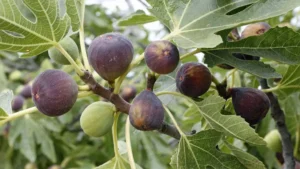
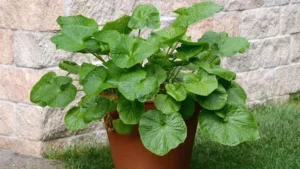





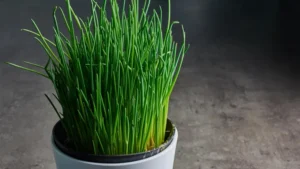
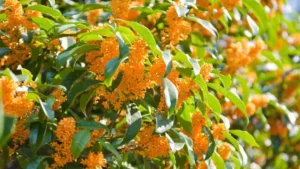
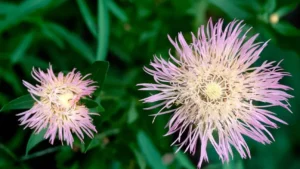

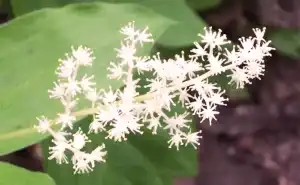
Leave your comment